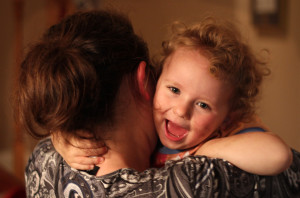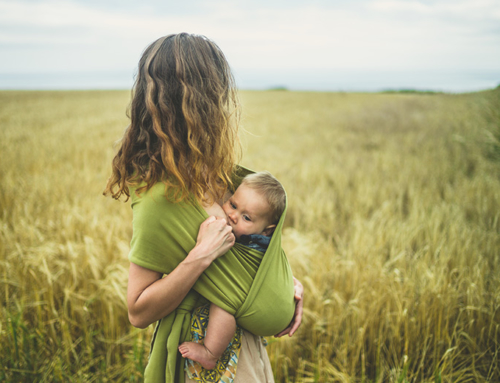 I’ve had this piece on my mind for quite some time to cover, but it seems the craziness that has erupted over the past week has been my impetus to actually talk about attachment theory versus ‘Attachment Parenting’. I know others have written on this before, but I’m going to throw my hat in the ring for those who haven’t read on the distinction and hope to clarify a few things.
I’ve had this piece on my mind for quite some time to cover, but it seems the craziness that has erupted over the past week has been my impetus to actually talk about attachment theory versus ‘Attachment Parenting’. I know others have written on this before, but I’m going to throw my hat in the ring for those who haven’t read on the distinction and hope to clarify a few things.
What is attachment theory? Attachment theory began with John Bowlby There have been, over the years, four different types of attachment patterns that we can see between infant and parent: secure, avoidant, anxious, and disorganized[2][3]. Secure attachment is what we strive for and is characterized by a child showing some distress when separated from their parent, happiness at their return, and a generalized preference for their parents over others. Avoidant attachment is characterized by a lack of preference for the parent over other strangers; these children rarely seek out their parents for comfort. Anxious attachment is characterized by distress when separated from the parent, but a lack of comfort upon the parent’s return and may in fact be quite hostile towards the parent upon returning. Finally, disorganized attachment is characterized by a mixture of avoidant and anxious behaviours. The final three attachment patterns cluster together under the term ‘insecure attachment’. Although not all children with insecure attachments will develop later psychopathologies or generalized problems, the likelihood that they do is far greater than for children with secure attachments[4]. So how do we get our child to be securely attached? Isn’t this the question most parents want the answer to? Well, in one sense the answer is incredibly easy: Respond to your child[5]. But what the means opens up a whole other debate, and this is where attachment parenting seems to come into play. Though Dr. Sears formalized the term Attachment Parenting, even his 7 B’s were taken from John Bowlby’s work (yes, AP is a Dr. Sears term, but the roots of it go far beyond him). You see, Bowlby in his initial research believed that early attachment was fostered in environments like those of historic and modern hunter-gatherer societies[1]. These societies, as I have focused on here on EP, shared many premises with what Dr. Sears termed Attachment Parenting and what Darcia Narvaez has studied with respect to moral development and infant outcomes[6]. Infants in these societies are typically breastfed on demand, held close to a parent nearly all the time, are responded to immediately when they cry, birth is a natural event free of interventions (and babies are immediately given to mom post-birth), and infants sleep close to their caregivers. In Bowlby’s view, this type of behaviour fostered immediate responsiveness and thus, attachment. Importantly to the discussion at hand, the timing for this attachment to grow was hypothesized to be between six months and two years. Of course, we know today that infants and children will form secure attachments with myriad parenting practices at play so long as the parent is responsive to his or her child. If you don’t believe me, let me tell you that on average, 70% of children in the United States are securely attached[2], yet we know that 70% of families do not engage in parenting that would be classified as akin to hunter-gatherer parenting. [UPDATE: New large-scale research on attachment now shows that only about 60% of children are “securely attached”. This is depressing, but sadly isn’t too surprising as many popular parenting methods actually promote detachment instead of attachment.] Additionally, Bowlby’s time frame of six months to two years is correct if taken as a guideline rather than a strict all-or-nothing phase. But yes, the first two years are generally most important to a child’s developing attachment. What does this mean for Attachment Parenting? Well, first, let’s be clear that the 7 B’s Dr. Sears speaks of (birth bonding, breastfeeding, babywearing, bedding close to a baby, belief in the language value of your baby’s cry, beware baby trainers, and balance) are not all-or-nothing rules for creating attachment (nor does Dr. Sears claim they are). If the work of Bowlby and others means anything, it really tells us that they are practices that can help us develop a healthy attachment. They work by keeping us close to our infants, ensuring a sense of security for the infant, and also by being so close, we become more responsive to our infants, but this does not mean they are the only way. Think of it as learning to run: Most people find the couch to 5K programs to be amazing and they are developed with your body’s physiology in mind, meaning that if you follow them, you will most likely succeed at reaching 5K in your time frame. However, following them to a tee will not work for everyone and many people will tweak a program to suit their needs. And they’ll still run that 5K. Others will try a different program and still end up running the 5K, though perhaps if they completely abandon the premise of the program, they will have, on average, less success. People forget that because these are just tools, if we don’t treat them as tools and instead as rules, we are no longer listening and being responsive and therefore ignoring the basic premise of attachment parenting. So what is the real premise of attachment theory and attachment parenting? It’s responsiveness. It’s listening to your child and responding to his or her needs. And early in life, all your child has are needs. As your child ages, there will be wants mixed in, but believe it or not, most things that will cause them distress will be needs. And in this we must remember that their needs will be very different from our own and we must not place adult expectations of what they can and cannot handle on our children. But there are a couple more things. First, often what gets left out of the discussion is child temperament. Some children are just as content sleeping next to a parent versus sleeping in a crib in the same room. Some are highly distressed at not having that physical contact. Some children will happily roll around town in a stroller. Some won’t. Some will love breastfeeding and want to feed for years, loving every second. Some will do it, enjoy it to a degree, and be done much earlier. The 7 B’s of attachment parenting (or what I like to consider just evolutionary parenting, seeing as its roots exist in our history and evolution) are most likely to be helpful for those with these higher needs children. Many parents can be responsive to their children by just believing that their infant’s cries are telling them something and responding appropriately. They may formula feed, have had a traumatic birth, sleep apart from their child, use a stroller, but they believe that their child is telling them something when they cry. They don’t dismiss it and they respond. That responsiveness is what is building their secure attachment. (Although as many parents of high-needs children will tell you, if you believe in that cry, you will almost certainly find yourself doing many of those AP things naturally.) Would many of us suggest they try babywearing or co-sleeping or breastfeeding? Absolutely. But not because their child will lack a secure attachment, but because we believe it to make that process easier for everyone involved. Of course, our belief in that is speaking in generalities, not individual circumstances, and so when you read such suggestions, it’s important to know that we are speaking not specifically to you, but to everyone and as such, we are generalizing. The second issue is that we have inadvertently limited attachment parenting to those parents of younger children as the 7 B’s focus solely on infancy. Now, I do know that attachment is predominantly built in the first two years; however, we also know it is malleable. Part of why it often doesn’t change beyond two years is that people continue to parent in a similar manner. However, a parent who may have missed the boat for the first five years with respect to responsiveness but turns around and starts to realize that they need to listen to their child and learn how to provide what that child needs is an attachment parent (though it may take longer and be a rougher road to reach the stage where benefits are seen in the child). Similarly, a parent who does all 7 but then stops listening to the child when he or she starts speaking (versus crying) or provides only conditional love is no longer fostering secure attachment. All this is to say that attachment or evolutionary parenting is there to point out probably the easiest ways to form a healthy and secure attachment for most people. It’s about averages. But by no means does this mean that the specific practices are what define being an attached parent. If you want a definition, think only of responsiveness, because it is that and that alone that will lead to the bonding and secure attachment parents strive for. What that responsiveness looks like, well, it’s up to you. [1] Bowlby J. Attachment and Loss, Vol 1: Attachment. New York (1969): Basic Books. [2] Ainsworth M, Blehar M, Waters E, Wall S. Patterns of Attachment. Hillsdale, NJ (1978): Erlbaum. [3] Carlson V, Cicchetti D, Barnett D, Braunwald K. Disorganized/disoriented attachment relationships in maltreated infants. Developmental Psychology 1989; 25: 525-531. [4] Belsky J, Nezworski T (Eds.). Clinical Implications of Attachment. Hillsdale, NJ (1987): Erlbaum. [5] Grusec J. Socialization processes in the family: social and emotional development. Annual Reviews in Psychology 2011; 62: 243-269.






Beautiful.
Thank you 🙂
Great post Tracy! Been thinking v.similar myself and do think 'we' need to differentiate, it is an important difference yet so many (journalists!) don't seem to realise there is a difference.
Thanks Sarah! Yes, there really does need to be more discussion of this because I think it’s key that parents understand the distinction. And that’s truly unfair to them, eh?
Thank you so much for this – particularly the two points you elaborate on at the end. You are the first person I have come across to tackle the issue of attachment being malleable. I had the most dreadfully difficult start with my first baby: a difficult pregnancy and traumatic birth, then he suffered from terrible reflux for months and months. On top of this, the only baby book we had ever come across by this stage was (dare I say it…) Gina Ford!! Needless to say, I didn’t parent this way for long, and by about 1-year we were carrying him in a sling and responding to him left, right and centre!! I breastfed him for 8 months but he was never particularly crazy about it… We didn’t co-sleep – mainly because he would have absolutely filled our bed with regurgitated milk on a nightly basis!!! (this is no exaggeration BTW….) I berate myself continually for his ‘bad’ start, despite the fact that I have been very AP with him from an early-ISH age, just not right from the VERY start…. I’d be very interested to know if there are any other sources on info/material that you have on this? It would be great if I could finally let myself off the hook for what I have always seen as my (early) failures as a mother, despite my devotedness to him…
The infant temperament/predisposition thing is interesting too. Even when I did respond to my son as a baby, he didn’t always ‘respond’ to me – i.e.he was in such discomfort from the reflux that ‘comforting’ him very often didn’t actually have that effect…. It is very hard to feel that you are ‘responding’ to your child, when nothing you do can settle them!! I wonder if you have any insights on this?
With love, respect and thanks…
Esme
Esme,
First let me say you should definitely let yourself off the hook. You can’t hold yourself to standards you were unaware of 🙂 I would bet you that your son is very securely attached to you.
As for the reflux and settling issue, I’ve done a piece that should hopefully give you comfort regarding simply being there even if it doesn’t help settle in the moment: https://gku.flm.mybluehost.me/evolutionaryparenting.com/my-baby-cries-too/
You can read in detail, but the stress response associated with pain or psychological stress which we assume to be present when crying is actually blunted when a child is being held and comforted, even if the crying doesn’t stop. So you were actually providing key comfort to your son, even though you may not have actually witnessed this on the outside 🙂
Keep doing what you’re doing 🙂
Tracy
I appreciate this so much, thank you. Think I will go and have a good blub now 😉 !! One day I will make it my mission to reach out to other mums of babies that REALLY cry – not just your average ‘high needs’ baby, but those who take it to a whole other level! (I also have a daughter, born 4 years later who was AP-ed from the very start – always slept with us, breastfed till she was 2 and a half, etc – and I think actually she cried at least as much as, if not more than, my son!! (Digestive issues, again… It was terrible). I’m sure some great material could be written on this from an attachment parenting perspective. 🙂
Hi Tracy (and Esme) – A member of my mother and baby class mentioned this post in our discussions yesterday. If we are being honest (as I was in class – hoping that the parent and nanny in our class could learn something)…I still worry about my oldest son’s early start – he’s 35 now and going through a sad and very unexpected relationship breakup.
I know we did the best we could with our knowledge from the time he was born: he nursed for 2 years and spent wonderful evenings on the ‘big’ bed with his father reading to him as he got older; which they have parlayed into a very close bond (something I always hoped for and am so happy about). I ask myself how, temperament-wise, he came into this world after a ‘fight’ to be born naturally during a long labor and ended up as a C-section baby. So in my mind, even though we formed an easy nursing bond, his introduction to the world was somewhat traumatic. I don’t question the C-section at all because I wanted a healthy baby but he was born to an exhausted mother who was also 4000 miles away from her family in England and didn’t have a support system. I know my family would have helped and supported me as they did three years later when our second son was born.
Then again, I know we cannot always protect our babies and young children from unavoidable traumas as they grow up – we have to hope we build enough resilience into them. We are none of us prepared for the death of beloved grandparents, close family friends, or traumatic hospital stays (as my husband had 13+ years ago). Perhaps it is how we deal with those traumas that better equip us for future challenges?
We just have to keep love, love, loving our ‘babies’, in all the best ways! Good luck to us all! Thanks for posting Tracy.
Well said! I truly appreciate your very logical and analytical approach to these emotionally charged issues. I also appreciate your acknowledgement that attachment practices are focused on responses to the individual child’s needs instead of following a strict list of do’s and don’t’s. I often have parents contact me who feel they’ve missed the ‘attachment parenting boat’ because they’ve followed mainstream parenting practices for years. The first thing I share with them is just what you shared about the malleable quality of children’s brains and that the very first step to becoming a more intuitive parent is to listen, really listen, to their children. Thank you so much for this breakdown of attachment theory/parenting. Will be sharing!
Great post, definitely sharing! Reminds me of something I wrote last year, “Because after babyhood comes toddlerhood, and after toddlerhood comes childhood, and then adolescence, and then young-adulthood… And then how do we identify “Attachment Parenting”? Not by our breasts or baby carriers, not by where we sleep or what our children poop in. Nope, eventually all of our children grow up. So to me the real question is, are you LISTENING to your child? Because that is what attachment parenting really comes down to. ”
http://www.togetherwalking.com/1/post/2012/05/no-more-mrs-wishy-washy.html
Beautiful!!!
Thank you so much for writing this. I have been thinking all day about attachment parenting and what it actually means due to the eruption of craziness you mention. (Just realised the date of this post but it is the “the great attachment parenting con” article and the follow up on Nurshable that have been getting me thinking)
I have been trying to work out why I struggle so much with the label “attachment parenting” and you have really helped clear the fog in my mind. The bit about child temperament is so right. I feel like I do not fit it with the attachment parenting crowd because I am not “enough” of an attachment parent, but I know full well I am trying my damn hardest to respond to my baby’s ( well toddler’s) needs and actually I am not doing a bad job of it.. Even if he does sleep in a cot now in his own room. Even if when he was little he much preferred taking his naps in his cot instead of in a carrier.
I was going to try and write my own post about my thoughts on attachment parenting but you have pretty much said everything I wanted to say. Maybe it has been written before like you say, but I have never read it before so thank you!
Thank you! Your son will love you for responding to him instead of forcing something because a book told you – no matter how nice the book is 🙂 And I saw the con article too which just made me sad all over again. It seems I could write this piece over and over and over…
You make a really good point. AP should never be a dogmatic approach, but a responsive one. However, there is a bit of a slippery slope here. Some children are just as content sleeping next to a parent versus sleeping in a crib in the same room.
See, when we look at the biology of children, it tells another story. Babies who are sleeping in another room and seem relaxed, also have higher cortisol levels. These levels can wire the brain and make them more sensitive for stress later in life. Parents in countries where co-sleeping is the norm, would interpret their baby’s fuzziness differently. They would not conclude that the baby needs to sleep separate from them.
It may not be the attachment that is in danger, but we have to acknowledge that we aren’t always capable of interpreting a baby’s needs, no matter how responsive we are.
Please note I said sleeping next to the parent or in a crib in the *same* room 🙂
I’m sorry, English isn’t my first language. What I mean is that it *can* be a slippery slope, because the way we interpret our child’s behavior or needs may be coloured by our culture and our social upbringing.
Thank you for setting the record straight! As a foster parent I care for children who are “attachment compromised.” But first I was an Attachment Parent with my bio children. I’ve seen both sides of this first-hand (the difference between attachment and Attachment Parenting). And I can tell you that building bonds and attaching with children is vitally important, but you’re absolutely right that either way it all stems from responsiveness.
[…] The fact is, there is a huge difference in attachment versus AP […]
Hi, thank you for such a clarifying article!
I have a blog in Brazil where I talk about attachment parenting, considering the experiences I’m having with my baby. It’s a good thing specially because there’s not a lot of information regarding attachment parenting avaliable in our language.
So, whenever I come across great articles like this one, I feel I should translate it and spread the word in my country. Do I have permission to do this? All credits to site and author will be maintained, of course!
Thanks!
Yes you may translate it provided you provide credit and a link to the original as well as provide me with a link to the translation (so I can share it here too)!
Cheers 🙂
Tracy
Hey, Tracy.
Thanks a lot, I will do so 🙂
See you!
Thiago
[…] mom but certainly not always given the high prevalence of alloparenting in these societies), as I’ve written about before it’s really all about responsiveness. Whereas leaving your baby to cry or refusing to feed or […]
Hi, can you recommend any reading for how this works with older children? I worry about the difficult start I had with my daughter now aged 8. I still find her the most difficult to respond to ( I have 3 other children also). Many thanks
I should do a piece on it, as it’s a question that comes up. But to help you personally, can you email me? tracy@evolutionaryparenting.com
[…] mom but certainly not always given the high prevalence of alloparenting in these societies), as I’ve written about before it’s really all about responsiveness. Whereas leaving your baby to cry or refusing to feed or […]
[…] Parenting did a fantastic job of comparing AP and the attachment theory HERE, and also added their own term to the mix: “evolutionary […]
[…] to get this, I think Tracy at Evolutionary Parenting has done a fabulous job of this in this post here, so please do go and read it! Attachment to me, the philosophy, NOT the tools, is about love, and […]
[…] mom but certainly not always given the high prevalence of alloparenting in these societies), as I’ve written about before it’s really all about responsiveness. Whereas leaving your baby to cry or refusing to feed or […]
[…] [1] Bowlby J. Attachment and Loss, Vol 1: Attachment. New York (1969): Basic Books. […]
Thanks for the article!
Esme, your story is mine, thanks for your comment and putting into words your experience because I can relate 200%
I work hard on building attachment between my toddler and me, but it is not as easy as with my 1 year old… I try and then I am lost not knowing if I am over reacting to all his needs and demands to the point that he will take advantage of this..:
When do we stop being positively responsive and begin spoiling and acting out of guilt for their hard start ( prematurity/reflux/c-section/etc) ? I am not sure if I can explain myself?
I think it comes down to looking at what is being asked. Are you giving a child a cookie to keep them from being sad or are you withholding love when they are sad? These are critical distinctions!
[…] The science: here, here, & here […]
Interesting article, one thing I would add is the needs of the mother. How well is she listening and responding to her own needs?
I know I came from not feeling responded to by the main care giver, grandmother in the house over caringly stepped in. Everyone doing the best they knew how to yet it left me with that dynamic to deal with and parent differently from. Each little family unit so unique, so complex.
Mums, get feeling into your own complex story gently bringing clarity of motivation to parent this way or that, get feeling into your own deep inner needs. Do not abandon yourself as you reach for your best parent self for your child. Self care as you go. Where are you responding from, endeavouring to respond from? Bring love there first. Self Compassion heals. And then from that clear secure land birthing, parenting, living, is authentic. Just is. You can be raw, real, present, love. Love love love.
[…] θεωρία του ασφαλούς δεσμού ξεκίνησε από τον John Bowlby και συνεχίστηκε από την Mary Ainsworth ως μια θεωρία η οποία […]
[…] předurčuje bezpečnou citovou vazbu u našich dětí a každý rodič jim to může poskytnout (zde si můžete zatím jen v angličtině přečíst […]
[…] I have written extensively on the importance of attachment to our children’s well-being, but let me be clear: Insecure attachment is associated with an increased risk of a host of problems ranging from mental health disorders to relationship problems to more (for a review, see [1]). As parents, we need to acknowledge that our children’s psychological well-being is equally important to their physical well-being. We know the extreme cases where children are physically cared for, but left without comfort, and the devastating effects. Most of us don’t even get close to that extreme, yet still 40% of our kids are insecurely attached [2]. Forty percent. This shows us that something is going wrong in early parenting on a large scale that we should all be talking about and trying to figure out how to address. But know that love, and most importantly, responsiveness is what predicts our children’s secure attachment and any kind of parent can provide that (click here to read more). […]
[…] that the absence of evidence is not the same as the absence of harm and that the wide body of research on attachment can be extrapolated from to assume that sleep training has negative effects. I’m sympathetic to […]
[…] Starting your attachment parenting journey means creating a caring space for your baby. An attachment parenting guide offers tips and techniques to help. By focusing on being responsive and emotionally connected, you can build a strong bond with your child21. […]